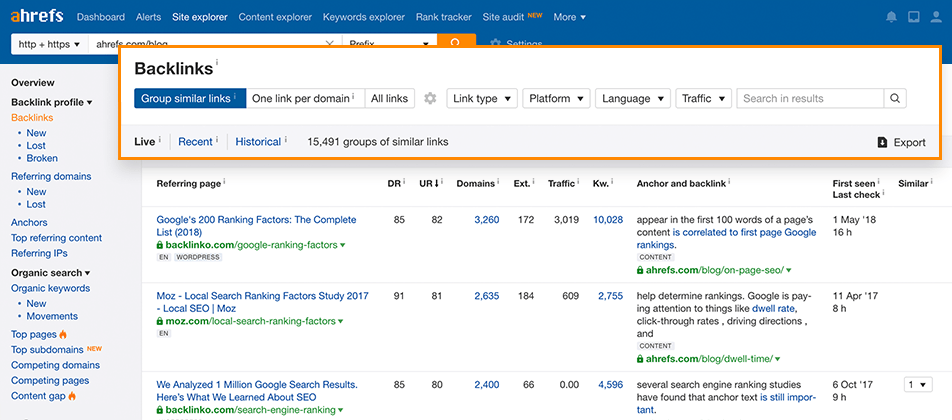Table of Contents
Online businesses appreciate that affiliate marketing is one of the most efficient ways to increase sales. Its low-cost and performance-based model of marketing products and services also make it more preferable to email marketing. As a matter of fact, statistics show that affiliate marketing will soon surpass email marketing by the end of 2021.
That said, affiliate marketing is considered to be one of the best ways to monetize a blog. So, finding a good partner is beneficial. Even so, any online business can relate to how taxing it is to find the right affiliate marketer.
An affiliate partnership isn't just about link building, but finding a partner with similar goals and can give you access to their customer base (and vice versa).
Many ideas come to mind when looking for an affiliate marketer: joining affiliate recruitment agencies, reaching out to networks, or partnering with influencers. But there’s a surefire method that is often ignored — examining affiliate link structures.
In this article, we’ll explore the structure of an affiliate link. Then, we’ll explain how to identify a competitor’s affiliate URL along with the affiliate marketer who is doing the promoting.
In the event you’d like to recruit a found affiliate, we’ll also show you how to reach out in a professional a persuasive manner. Let’s get started!
What is an Affiliate Link?
An affiliate link is a special URL that has a unique affiliate ID. It helps identify your website and drive organic traffic to specific websites. Merchants also use them to identify who sent traffic to their sites and determine whom to credit a sale.
Identifying affiliate links a competitor uses can help businesses reach out to affiliates. The ultimate goal here is to introduce your business and invite the affiliate to join your affiliate program and benefit from their impressive marketing skills.
Typically, affiliate links are similar to other URLs, except they have additional information, such as the affiliate’s ID or website and the specific page you’re advertising to help the customer land on the right page.
The placement of these features in the string varies based on the merchant. For example, Amazon Affiliates place the site ID after the offer ID, while other networks do the opposite.
This is an essential feature to factor in because you may end up crediting another affiliate with your sale if you get it wrong.
How Do You Identify Websites Using Affiliate Links?
Identifying affiliate links is an uphill task because many affiliate bloggers hardly disclose this additional information. Online merchants like Amazon require affiliate marketers to disclose this information to the audience, but many other marketers don't comply with this rule.
If affiliates do disclose this information, it’s only after the content is curated. As a result, most marketers track referral traffic from marketers using custom links.
This means that instead of linking to a regular website address, it includes a unique identifier that can help you track the referral.
Example of Amazon Affiliate Link:
https://www.amazon.com/dp/B073QXYW38?linkCode=ogi&tag=goodhousekeeping_auto-append-20&ascsubtag=[artid|10055.g.399[src|[ch|[lt|
If the code after the product ID (B073QXYW38) is removed, the link (https://www.amazon.com/dp/B073QXYW38) still works because the values after the product ID show how the customer found the product.
The code after the product ID is the link identifier. In our example, it’s linkCode=ogi&tag but in most cases ‘?tag=097-20’ is used. This code identifies the content creator who sent the reader to Amazon to purchase the product. In our example, the blogger’s ID is Goodhousekeeping.
With thousands of affiliate programs, it’s essential to identify possible identifiers without actually clicking on the link. One method is to keep an eye out for these four words in URLs you suspect to be affiliate links:
- ref
- aff
- rid
- refid
The words are often followed by an ‘a’ or ‘=’ and a word, number, or name, which is the affiliate marketer’s ID.
Using a Link Analysis Tool to Find Affiliate Links
If you know what you’re looking for, you can easily spot affiliate marketing. Here’s a step-by-step guide to help you spot competitor practices.
The first step to finding reliable affiliate bloggers is to look for a tool specially designed to discover and analyze backlinks. For this discussion, we’ll use Ahrefs because it focuses on backlinks to provide marketers with in-depth insights about new and lost backlinks. Its primary tasks include:
- Reviewing competitor link profiles to discover link building opportunities
- Identifying top-performing competitor content to identify new ideas for content strategy for your site
- Finding websites linking to broken pages on your site

After signing up with Ahrefs, open the website and paste the domain or URL, e.g., https://competitor.com
Choose the exact domain or URL mode from the drop-down menu.
View the backlink report on the left-hand menu:

You’ll see the backlink the competitor uses and lots of data including the site’s traffic (the estimated search traffic to the linking page), referring page (where the link originates), and anchor text (the text using in link building).
Next, export the links from Ahrefs into an Excel sheet to create a list of links you can use for link building.
How to Reach Out to Affiliate Bloggers
After you’ve compiled a list of links, you still need to find the email addresses for the affiliates in order to reach out.
Most bloggers don't mind helping a growing brand. Besides, it's a win-win situation; they can earn passive income and you can advertise your products to their audience. However, the way you approach them can make or break your marketing strategy.
Here are 7 tips on how to reach out and connect with affiliates
1. Cut to the Chase: Use Grovia
If you want the most complete affiliate recruitment solution on the market, you should check out the Partner Discovery software at Grovia. This tool finds top-ranking content publishers for the keywords you want to rank for.
Grovia gives you links to relevant sites and contact information for authors, editors, and decision makers. It collects your contacts in the CRM, then allows you to create custom email sequences from the dashboard. We'd happily recommend this time-saving tool to any affiliate manager.
2. Write a Straightforward Message
The blogger may have other marketers requesting to advertise through their platform, so you want to get to the point right away. Note that there’s a fine line between being careless and straightforward too. You don't want your email to end up in the trash.
3. Make an Offer
This is one question that goes through the blogger’s mind when you ask them to promote your product or service. Unless you’re a big brand, you’re bound to gain more customers through link building. The offer should be tailored to the blogger you’re talking to. For bloggers, it can be a percentage of the sales made.
4. Tailor the Email to Each Blogger
It’s tempting to create an email list and pitch using the same email to all the recipients. Although, we recommend that you take the time to personalize your message. Every blogger is different; a paid review offer may lure some while others may find it off-putting.
As such, it’s essential to tailor the pitches to the blogger’s preferences. Research the types of blog posts they like and what they’re currently doing to earn a living. Such information can help you write a good pitch and woo them with an attractive offer.
Be as creative as you can! You can even create short videos using video editors like Movavi so your email stands out.
5. Ask them to Review Your Product or Service
Product reviews are an effective affiliate marketing strategy. Although, it’s important that a blogger’s content is related to your products or services.
6. Send a Follow-up Email
Sending a follow-up email shows the blogger that you want to work with them. They also come in handy if they didn't read the first email, or it got lost. It’s best to leave a good impression even if they don't respond.
7. Offer a Unique Commission
If you’re going to ask a blogger to be an affiliate, it’s best to give them a different commission. Such incentives encourage them to promote your products regularly.
Wrapping Up
Affiliate marketing remains the most effective way of increasing reach and sales or growing a brand, but the strategy you use matters. Analyzing affiliate link structures from competitors and other sources is a good start because it makes it easy to find potential affiliate bloggers.
In this article, we covered:
- How to identify websites that use affiliate marketing
- How to use a link analysis tool, such as Ahrefs, to find affiliate links
- How to reach out to marketers and recruit them to your affiliate program
When it comes to blogging, rankings are primarily dictated by content quality; thus, finding out where your competitors are linking might just put your business ahead in the affiliate marketing game.
If you liked this post, be sure to follow us on Twitter, Facebook, and LinkedIn! And don't forget to subscribe to our newsletter.



A really great grounding for anyone in digital marketing to get a good understanding of how the blogger / influencer / affiliate landscape has developed over the last few years! Thanks
Thanks Chris 🙂
These are awesome ways to reach out to them! I am really happy to get this list of ways. I appreciate you for sharing your through with us. Especially, “Send a Follow-up Email” is the most important to remember and follow. Thank you so much and keep it up!